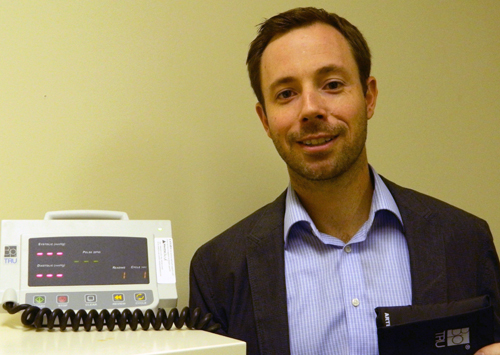
In the past, people who had heart attacks often didn’t survive. Today, many do, but they often develop a condition known as heart failure. Once the heart has been damaged, it has difficulty pumping enough blood to meet the body’s needs, which can be fatal.
Philip Millar, a new professor in the Department of Human Health and Nutritional Science, is studying the effects of heart failure on the body with the goal of understanding it better and, ultimately, providing better treatments.
One strategy involves studying the responses of the autonomic nervous system. “We know that people who have heart failure also have increased muscle sympathetic nerve activity (MSNA), and that this is associated with an increased risk of mortality,” he explains.
The technology Millar used in his research allowed him to measure the actions of individual sympathetic fibres, rather than a whole group of fibres as in previous studies. He recorded the responses of the fibres to changes in blood pressure in the heart and found that in healthy men, about 25 per cent of the fibres responded to a change in pressure in an abnormal way, while the other fibres responded normally.
In people who had heart failure, the majority of the fibres showed an abnormal response. “None of the healthy people showed this dominance of abnormal fibre responses,” he says. “This could be a mechanism for the increased MSNA in heart failure.”
This research was conducted during Millar’s post-doc work at the University Health Network in Toronto. He will continue to investigate the differential control of muscle sympathetic fibres at the University of Guelph.
During his post-doc, Millar and his colleagues also studied the neural responses to exercise in patients with heart failure. Participants were asked to ride a stationary bike by pedalling with one leg, while the other leg remained still so that electrodes could measure the reactions of sympathetic fibres directed towards the muscles.
“What we found was that those without heart failure had decreased MSNA, a response which should cause their blood vessels to vasodilate to get more blood to the muscles,” he says. “But those with heart failure actually had increased MSNA, a mechanism to make their blood vessels constrict. A common sign of heart failure is that you lose the ability to exercise, you feel tired very fast. This may be why.” Millar is interested in understanding the sympathetic responses to exercise in healthy and diseased populations and will explore this further at U of G.
Millar, who grew up in Welland, Ont., studied at McMaster University and eventually earned a PhD in kinesiology. “At one time, I thought I might go into medicine but I found research quite exciting, especially research with practical applications, and decided this was what I’d rather do.”
While at McMaster, he studied the treatment of hypertension (high blood pressure). Millar had a personal stake in this work: both of his parents have hypertension, and since there is often a genetic component, he anticipates that he will also develop this condition. In fact, most of us will, he says. “While about 20 per cent of us have high blood pressure at any one time, your lifetime risk of developing it is approximately 90 per cent. Aging plays a large component: as we get older, our blood vessels stiffen, and we are more prone to high blood pressure.”
Hypertension is commonly managed by medication but Millar says the most common recommendations are about lifestyle changes, including increasing exercise. “The standard is at least 150 minutes of moderate or more intense aerobic activity per week,” says Millar. “I wanted to see if other forms of exercise could also be effective.”
His research participants were first asked to squeeze hand-grips as hard as they could to measure the maximum level of force applied. Then they were asked to squeeze at just 30 per cent of that level (as measured by the hand-grips) for two minutes, then take a short break, squeeze for two more minutes, take a short break, and so on for four repetitions in total. “The entire session, including the breaks, takes only 11 minutes,” says Millar. The participants did this three times a week for eight weeks.
The results showed a greater reduction in blood pressure than is usually achieved with standard aerobic exercise. Blood pressure dropped after a single 11-minute round of exercise and was also lowered after the eight-week program. Overall, this form of exercise has been shown to produce an average drop of seven mmHg in systolic pressure and four mmHg in diastolic pressure (the top and bottom numbers in a blood pressure reading).
Millar says the decrease in blood pressure readings was larger in those who had higher blood pressures to start. This compares favourably to the aerobic exercise results of a drop of five mmHg in systolic pressure and three mmHg in diastolic pressure.
“I would never say give up aerobic exercise as it has many additional benefits besides improving blood pressure,” says Millar. But this type of workout, known as isometric exercise, could be a good add-on (in fact, Millar found there was an additional benefit for people who did both). It might also be very helpful for those who have limited mobility and difficulty doing aerobic exercise.
Another study he was involved in followed cardiac rehabilitation patients. “We found that the improvement in exercise capacity depended on how soon the patient started the rehab process. Those who started early within 114 days of having a cardiac event showed much better results than those who waited longer than 114 days.” Millar hopes these research results will encourage early admission into cardiac exercise programs.
“Our research continues to show that exercise is medicine. The body is designed to exercise, and it is an effective treatment for many diseases: cardiovascular disease, diabetes, cancer, depression and more. More time being active and less time in front of computer or TV screens is better for our health.”